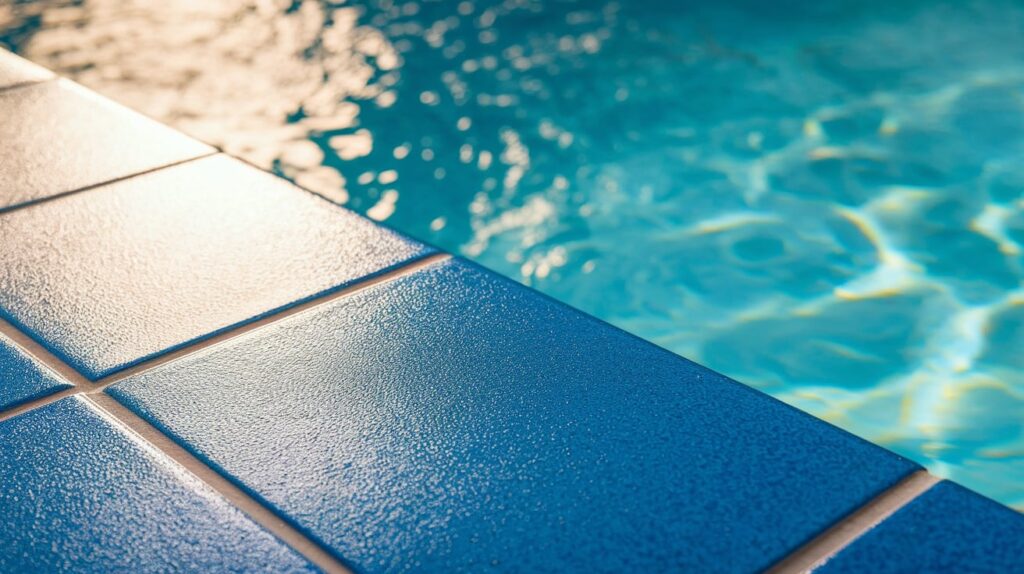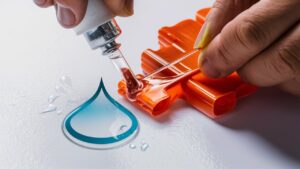Are you tired of seeing those stubborn white stains on your swimming pool tiles? If calcium buildup has taken over your pool, you’re not alone.
Recommended Best Pool Tile Cleaner in 2025
| Recommendation | Product |
| Best Overall | Clorox Swimming Pool Scale |
| Popular Choice | EasyCare Scaletec Plus Descaler and Stain Remover |
| Best Value | Bio-Dex #300 Tile Cleaner |
| Best Budget | Pool-Whiz Pumice Block Pool Tile & Concrete Cleaner |
| Another Excellent Pick | LayorCare Heavy Calcium Releaser |
Many pool owners struggle with this issue, but the good news is, you can restore your tiles to their original shine. Imagine diving into a pool that looks as pristine as the day it was built. That’s exactly what you’ll achieve by tackling this common problem head-on.
You’ll discover simple yet effective methods to clean calcium from your swimming pool tiles. Get ready to transform your pool into a sparkling oasis where you and your guests will love spending time. Let’s dive in!
Identifying Calcium Deposits
Calcium deposits can spoil the beauty of pool tiles. They appear as white or grayish spots. These deposits are not just an eyesore. They can damage the tiles over time.
Recognizing these deposits early is essential. Early identification makes cleaning easier. This guide helps you spot the signs and types of calcium buildup.
Signs Of Calcium Buildup
Calcium buildup often starts as small, white spots. These spots feel rough to the touch. Over time, they grow larger and more noticeable.
You might notice a chalky residue on the tiles. This residue can also form a line at the water level. If the water looks cloudy, it might indicate calcium buildup.
Types Of Calcium Deposits
There are two main types of calcium deposits. Calcium carbonate is the more common type. It looks like white, flaky scales on the tiles.
Calcium silicate is harder to remove. It appears as grayish deposits. This type needs more effort to clean.
Essential Cleaning Tools
Calcium deposits on pool tiles can be unsightly. They can affect the pool’s beauty. Removing these deposits requires the right tools. The right tools make the job easier and more efficient. Here’s a guide on essential cleaning tools you need.
Basic Cleaning Equipment
Start with a stiff brush. It helps scrub away surface deposits. Nylon brushes are good for delicate tiles. They do not scratch the surface. A pumice stone is effective for tougher stains. It works well on hard surfaces. Use it gently to avoid damage.
A bucket for water and cleaning solutions is handy. A sponge or soft cloth helps in wiping tiles clean. Ensure you have gloves. They protect your hands from chemicals. Safety goggles are also important. They prevent splashes from reaching your eyes.
Chemical Cleaners
Consider using a calcium dissolving cleaner. These cleaners break down calcium deposits. Read the instructions carefully before use. Some products require dilution with water. Always wear gloves when handling chemicals.
An acid-based cleaner is another option. These are stronger and remove stubborn deposits. Use them with caution. Test a small area first to check for reactions. Rinse tiles thoroughly after use. This prevents any residue from damaging the tiles.
Choose eco-friendly cleaners if possible. They are safer for the environment. They are also less harsh on the tiles. Always store chemicals safely. Keep them away from children and pets.
Natural Cleaning Methods
Keeping your swimming pool tiles free from calcium deposits can be a tough job, especially when you want to use natural cleaning methods. Many people are turning to eco-friendly solutions that are both effective and safe for the environment. You don’t need harsh chemicals to get your pool tiles sparkling clean. You might be surprised at how simple items found in your kitchen can do the trick. Let’s dive into some natural cleaning methods that can help you maintain your pool tiles without harming the planet.
Using Vinegar Solutions
Vinegar is one of the most versatile cleaning agents you can find. It’s not just for salads; it can be your ally in the battle against calcium deposits. Mix equal parts of white vinegar and water in a spray bottle. This solution is perfect for tackling those stubborn white spots on your tiles.
Spray it generously onto the affected area and let it sit for about 10 minutes. The acidity in vinegar works to break down the calcium buildup, making it easier to scrub away. After waiting, use a scrub brush or a non-abrasive cloth to wipe the tiles clean. You’ll notice how easily the deposits come off.
Have you ever thought about using vinegar for such tasks? It’s incredible how a simple household item can make such a difference. Not only does it clean effectively, but it also leaves your tiles with a fresh smell.
Baking Soda Scrub
Baking soda isn’t just for baking; it’s a powerhouse cleaner too. To create a scrub, mix baking soda with a little water to form a paste. This paste is mildly abrasive and can help scrub away calcium deposits without scratching your tiles.
Apply the paste directly onto the problem areas and use a soft brush or sponge to scrub gently. The baking soda will work its magic, loosening the calcium deposits for easy removal. Rinse the tiles with water afterwards to reveal a clean surface.
Have you ever tried using baking soda for cleaning? It’s amazing how it can effortlessly tackle those annoying calcium spots. Plus, it’s safe for your pool and the environment.
Are you ready to give these natural methods a try? They might just change the way you look at cleaning. Imagine having a sparkling pool without resorting to harmful chemicals. It’s a win-win for you and the environment.

Chemical Cleaning Techniques
Calcium buildup on pool tiles can be removed using chemical cleaning techniques. Vinegar or commercial descalers work effectively. Gently scrub the tiles with a brush to eliminate the residue. Regular maintenance prevents future deposits, keeping your pool tiles clean and sparkling.
Cleaning calcium deposits from swimming pool tiles can be a daunting task, but chemical cleaning techniques offer an effective solution. These methods are particularly useful when physical scrubbing falls short. Chemical options can penetrate and dissolve stubborn calcium buildup, leaving your tiles looking pristine and extending their lifespan.
Using Muriatic Acid
Muriatic acid is a powerful cleaning agent for removing calcium deposits. It’s a solution that requires careful handling due to its corrosive nature. Always wear protective gear—gloves and goggles are a must.
Start by diluting the muriatic acid with water. A typical ratio is one part acid to ten parts water. Apply the solution directly to the calcium deposits using a sponge or brush. You’ll notice the deposits fizzing and breaking down almost immediately.
After cleaning, rinse the tiles thoroughly with water to remove any residual acid. This step is crucial to prevent damage. Have you ever used muriatic acid for cleaning? How did it turn out?
Commercial Calcium Removers
Commercial calcium removers are specially formulated to tackle pool tile deposits. These products are often less harsh than muriatic acid and come with easy-to-follow instructions.
Choose a remover that suits your pool’s specific needs. Some brands offer eco-friendly options, which are great if you’re conscious about chemical usage. These removers typically require you to apply the solution, let it sit for a specified time, and then scrub or rinse it off.
One of the advantages of commercial removers is their ability to target calcium without harming tile surfaces. Have you considered the convenience of a ready-to-use solution for your pool maintenance?
In practice, both muriatic acid and commercial calcium removers provide reliable results. Which approach aligns with your cleaning style?
Preventing Future Buildup
Preventing future calcium buildup on pool tiles is essential for pool health. Regular cleaning is good, but taking proactive steps is better. It saves time and effort. Understanding how to prevent buildup keeps your pool looking great.
Regular Maintenance Tips
Regular pool maintenance stops calcium from settling. Brush pool tiles weekly. This removes early deposits before they harden. Use a nylon brush for this task. Avoid metal brushes which scratch tiles. Clean the pool filter every month. A clean filter reduces calcium levels. Inspect tiles for early signs of buildup. Early detection makes cleaning easier.
Water Chemistry Balance
Balanced water chemistry prevents calcium buildup. Test water weekly for pH, alkalinity, and calcium hardness. Keep pH levels between 7.2 and 7.6. Maintain alkalinity around 80-120 ppm. Calcium hardness should be between 200-400 ppm. Use pool chemicals to adjust these levels. Proper balance reduces calcium settling. Consult a pool expert if unsure about chemical adjustments.
When To Call A Professional
Keeping your swimming pool tiles free from calcium build-up can be a daunting task. You might try various DIY methods, but sometimes it’s crucial to know when you should call in the professionals. While you might be tempted to tackle the problem yourself, professional services can offer expertise and solutions that are both efficient and effective. Let’s dive into understanding when it’s time to pick up the phone and enlist professional help.
Assessing The Severity
Before deciding on a professional service, assess the severity of the calcium build-up. A light, powdery substance on your tiles can often be managed with a little elbow grease and some household products. However, if the calcium deposits are thick, crusty, or have been there for an extended period, this indicates a more severe problem that might require specialized equipment or chemicals.
Consider the size of your pool and the extent of the build-up. Large pools or those with extensive tile work can be overwhelming for a DIY approach. You don’t want to spend endless hours scrubbing tiles only to realize the problem persists. An honest assessment could save you time and frustration.
Benefits Of Professional Services
Professional pool cleaners come equipped with tools and techniques that can effectively remove stubborn calcium deposits without damaging your tiles. They have access to industrial-grade cleaning solutions that aren’t available to the general public. This means they can tackle even the toughest build-ups with ease.
Hiring professionals also ensures the job is done safely. They are trained to handle potentially harmful chemicals and tools, reducing the risk of damage to your pool or injury to yourself. Moreover, they can provide maintenance tips to help prevent future build-ups, giving you peace of mind.
Have you ever spent hours on a task only to find it wasn’t worth the effort? This is often the case with stubborn calcium build-up. Calling a professional might seem like an added expense, but it can save you time, effort, and potential headaches. Next time you find yourself battling a stubborn pool tile issue, ask yourself: Is it time to call in the experts?
Frequently Asked Questions
How To Get Calcium Buildup Off Pool Tile?
Use a pumice stone or vinegar solution to scrub calcium buildup off pool tiles. Rinse thoroughly after cleaning. For stubborn stains, try a commercial descaling agent specifically designed for pools. Regular maintenance helps prevent future buildup. Always wear protective gloves when handling cleaning agents or tools.
How To Remove Calcium Build Up From Tiles?
Use vinegar and water solution to scrub tiles gently. Apply baking soda for tough spots. Rinse with water.
Does Clr Remove Calcium From Pool Tile?
CLR can effectively remove calcium deposits from pool tiles. Apply CLR directly to the affected area. Scrub gently with a brush and rinse thoroughly. Always follow safety instructions on the label. Regular maintenance can help prevent calcium buildup and keep pool tiles clean.
What Dissolves Calcium In Pools?
Muriatic acid effectively dissolves calcium deposits in pools. Regularly check and balance pool pH levels to prevent buildup. Use a calcium reducer to maintain optimal water quality. Ensure proper filtration and circulation to minimize calcium accumulation. Consult a pool professional for persistent issues or large calcium deposits.
Conclusion
Clearing calcium from pool tiles keeps your pool looking fresh. Regular cleaning prevents build-up and saves future hassle. Use vinegar or baking soda for a natural solution. Always wear gloves for safety. A pumice stone can help scrub stubborn spots.
Consider a professional cleaner for large pools. Consistent maintenance is key to a clean, inviting pool. Enjoy your swim without worrying about unsightly calcium deposits. Keep your pool tiles shining bright with these simple tips. Happy swimming and cleaner tiles for everyone!








